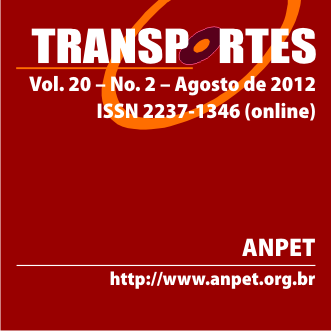Proposta de um modelo matemático para o problema dial-a-ride aplicado ao transporte público de cadeirantes
DOI:
https://doi.org/10.4237/transportes.v20i2.501Abstract
O presente artigo propõe um modelo de Programação Linear Inteira Mista para resolver o problema de roteamento denominado de Dial-a-Ride Problem – DARP. O DARP consiste no problema de roteamento de demandas onde os veículos saem da garagem, buscam e entregam os clientes nos locais e horários solicitados, e retornam para a garagem, tendo como objetivo a minimização dos custos de atendimento. Diferente do que é comumente encontrado na literatura, o modelo aqui proposto considera restrições de janela de tempo na origem e no destino e uma frota de veículos heterogênea. Alem disso, o modelo também possibilitou a redução do número de veículos usados. Visando uma aplicação real do modelo proposto, o mesmo foi testado com dados reais fornecidos pelo programa Porta a Porta da Prefeitura de Vitória - ES. O modelo foi executado no software CPLEX e os resultados mostraram que cenários com grande número clientes (20) podem ser resolvidos otimamente com essa formulação.
Palavras-chave: dial-a-ride problem, programação linear inteira mista, transporte público de cadeirantes.
Abstract: This article proposes a mixed integer linear programming model to solve the routing problem called Dial-a-Ride Problem - DARP. The DARP consists of a demands routing problem, where vehicles leave the garage, pickup and deliver customers at requested locations and times, and return to the garage, aiming to minimize the cost of the services. Differently from literature, the model proposed considers the origin and sink time windows and the use of an heterogenous fleet of vehicles. In addition, the model allow a reduction on number of vehicles used. Aiming a real application of the proposed model, it was tested with real data from the city of Vitória, provided by the Secretary of Infrastructure and Transportation. The model was implemented using CPLEX and the results showed that scenarios with a large number of wheelchair users (20) can be solved optimally.
Keywords: dial-a-ride problem, mixed integer linear programming, wheelchair public transport.
Downloads
Downloads
Published
How to Cite
Issue
Section
License
Authors who submit papers for publication by TRANSPORTES agree to the following terms:
- The authors retain the copyright and grant Transportes the right of first publication of the manuscript, without any financial charge, and waive any other remuneration for its publication by ANPET.
- Upon publication by Transportes, the manuscript is automatically licensed under the Creative Commons License CC BY 4.0 license. This license permits the work to be shared with proper attribution to the authors and its original publication in this journal.
- Authors are authorized to enter into additional separate contracts for the non-exclusive distribution of the version of the manuscript published in this journal (e.g., publishing in an institutional repository or as a book chapter), with recognition of the initial publication in this journal, provided that such a contract does not imply an endorsement of the content of the manuscript or the new medium by ANPET.
- Authors are permitted and encouraged to publish and distribute their work online (e.g., in institutional repositories or on their personal websites) after the editorial process is complete. As Transportes provides open access to all published issues, authors are encouraged to use links to the DOI of their article in these cases.
- Authors guarantee that they have obtained the necessary authorization from their employers for the transfer of rights under this agreement, if these employers hold any copyright over the manuscript. Additionally, authors assume all responsibility for any copyright infringements by these employers, releasing ANPET and Transportes from any responsibility in this regard.
- Authors assume full responsibility for the content of the manuscript, including the necessary and appropriate authorizations for the disclosure of collected data and obtained results, releasing ANPET and Transportes from any responsibility in this regard.










